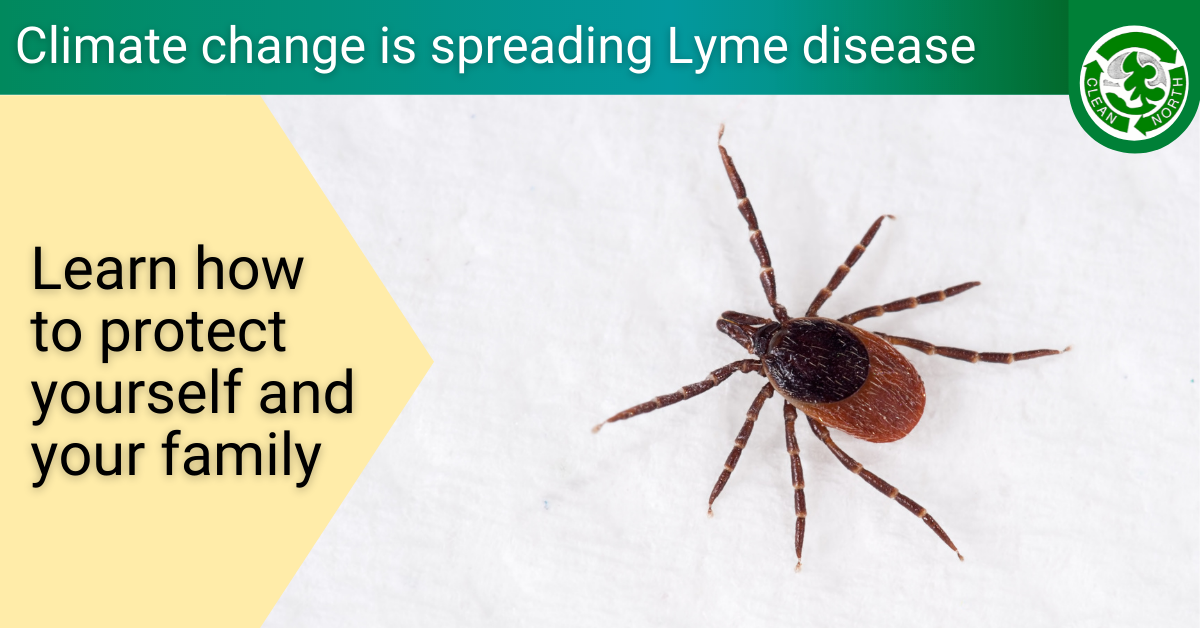
The black-legged tick that carries Lyme disease used to be rare in Canada — but warmer winters due to climate change are allowing this species to spread unchecked. As this tick has flourished, Lyme disease, once rare in Canada, has become much more common. You can find an infected tick almost anywhere in Ontario — even in Sault Ste. Marie/Algoma District.
Adding to our Lyme disease problem is the fact that many Canadian doctors are less familiar with it. As a result, many cases are not being diagnosed or are diagnosed late when treatment is much more challenging. People with untreated Lyme disease can suffer horrible long-term health issues.
The spread of Lyme disease in Canada is a prime example of how failing to address climate change can cause serious health threats. We need to hold our elected leaders accountable for failing to act. But in the meantime, what do we need to know about Lyme disease to keep ourselves and our families safe?
What is Lyme disease?
This illness is caused by a bacteria carried by black-legged ticks, also known as deer ticks. It causes an inflammatory infection with a wide variety of symptoms, which can come on quickly or slowly, making it tough to diagnose. Lyme disease often mimics and may be dismissed as the flu.
During the disease’s first stage, the infected person may have a distinct bulls-eye rash. However, most infected people don’t develop or don’t notice this rash. In fact, people often don’t even know they’ve been bitten by a tick. These critters love to attach to hard-to-see areas like your underarm or behind an ear. Plus many infections are caused by immature ticks, which are very tiny so hard to see.
Lyme disease is best treated immediately. If it’s not treated right away, those infected can end up with serious issues like heart and neurological problems and arthritis. And unfortunately, even when Lyme disease is properly diagnosed, it’s often undertreated, according to the Canadian Lyme Disease Foundation.
The best cure? Prevention!
With Lyme disease, the best strategy is definitely prevention! Some tips:
- Know when ticks are most likely to be out — May-September
- Be cautious in areas with shrubs and/or tall grass, which ticks like to climb up to wait for an animal or person to brush past
- When in natural areas that ticks might frequent, wear light-coloured clothing (easier to see ticks), a long-sleeved shirt, long pants tucked into your socks, and closed-toe shoes
- Use insect repellent
- Check yourself and your children after time in the bush or on trails — look behind knees, under arms, behind ears, in belly button/groin areas, and on the back
- Check your vehicle, equipment/packsacks, and dogs, too
- To deter ticks on your property:
- Mow grass short
- Trim bushes/tree branches to let in sunlight into the main part of your yard where your family gathers (ticks don’t like hot, dry areas)
- Create a border of gravel/wood chips around your yard if you are next to a wooded/grassy area
- Avoid creating piles of leaves, brush, and weeds near where your family hangs out
- Put children’s play structures away from wooded areas and consider putting mulch under them
“Eek! I found a tick on me! What do I do??”
- If the tick is attached, use fine-tipped tweezers or a tick removal tool to grasp the tick as close to your skin as possible (do not use your fingers)
- Pull the tick straight out gently but firmly
- Be sure to remove the entire tick (including the head)
- Avoid squeezing or crushing the tick
- After removing the tick, seal it in a jar or ziploc bag and try to identify what type it is (upload tick sightings to Etick) — if it’s a black-legged tick keep it (carefully sealed!) in the fridge in case you develop symptoms (you can also take it to Algoma Public Health for testing)
- Thoroughly clean the bite site with rubbing alcohol and/or soap and water.
- Important: Do not burn the tick, paint it with nail polish, or cover it with petroleum jelly (increases the risk of infection)




